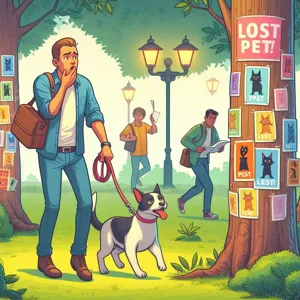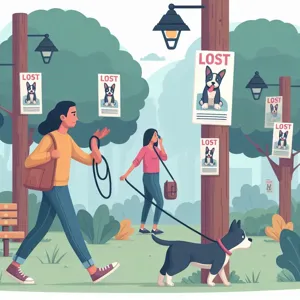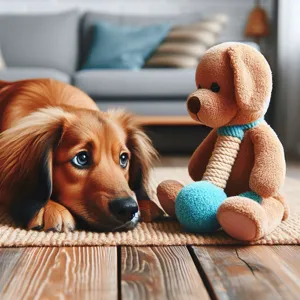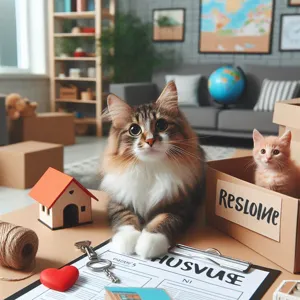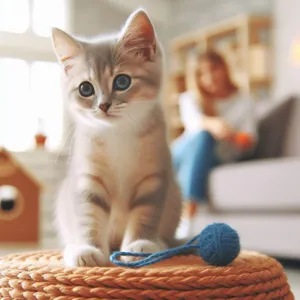Welcoming a furry friend into your home is an exciting journey filled with love, companionship, and a few challenges along the way.
One of the most significant hurdles new dog owners face is potty training, particularly when it comes to mastering the litter box. While traditionally associated with our feline friends, litter box training for dogs is an effective and practical solution, especially for those living in apartments or with limited outdoor access. In this comprehensive guide, we’ll walk you through each step of the process—from choosing the right litter box and materials to establishing a consistent routine and reinforcing positive behavior. Whether you’re a first-time dog owner or looking to refine your pup’s training, this guide will provide you with the tools and confidence you need to ensure a smooth and successful litter box experience for both you and your beloved canine companion. Say goodbye to accidents and hello to a cleaner, stress-free home!
1. Understanding Your Dog’s Natural Instincts

Understanding your dog’s natural instincts is the foundation of successful litter box training. Dogs, like their wild ancestors, have inherent behaviors that dictate their approach to elimination. In the wild, animals instinctively seek out specific areas to relieve themselves, often choosing spots that are away from their living and sleeping spaces. This instinct is deeply rooted and can be harnessed to facilitate the training process.
Take a moment to observe your dog’s behavior during walks or when they are outside. You may notice them sniffing the ground, circling, and even scratching at certain spots before they go. This is their way of assessing the environment and signaling that it’s time to do their business. By tapping into these natural tendencies, you can create a comfortable and appealing litter box experience for your furry friend.
Additionally, it’s crucial to consider their age and breed. Puppies, for instance, may not have full control over their bladders yet, making patience and frequent opportunities for elimination essential. On the other hand, older dogs may have developed preferences based on past experiences. Understanding these nuances will help you tailor your approach to your dog’s specific needs.
When introducing the litter box, choose a location that mimics the privacy they would seek in nature. A quiet corner of your home, away from loud noises and foot traffic, will help your dog feel secure and more inclined to use the box. Pay attention to their body language and cues; recognizing when they are about to relieve themselves can help you guide them to the box at the right moment.
By aligning your training methods with your dog’s instinctual behaviors, you can foster a positive association with the litter box, paving the way for a successful transition. Remember, it’s all about understanding your canine companion and working with, rather than against, their natural inclinations.
2. Choosing the Right Location for the Litter Box
Choosing the right location for the litter box is crucial in ensuring your dog feels comfortable and confident using it. Dogs thrive in environments that are quiet, safe, and easily accessible, so selecting the perfect spot requires careful consideration.
Start by observing your dog’s usual bathroom habits. Does your furry friend prefer secluded areas for their business? If so, placing the litter box in a corner of a low-traffic room may be ideal. Avoid high-traffic areas like hallways or rooms where family members frequently gather, as these can create distractions that deter your dog from using the box.
Moreover, ensure the litter box is located near the door to the outside if you have a backyard. This proximity helps reinforce the idea that the litter box is an acceptable place to relieve themselves, while also providing a quick exit to the outdoors when needed. If you’re using a specific type of litter, make sure to keep it consistent and place the box in an area where it won’t be disturbed by other pets or children.
Light is also an important factor; choose a location that is well-lit but not harshly illuminated. Your dog should feel relaxed and secure in their chosen spot, so consider placing the litter box in a spot where they can feel at ease without feeling exposed.
Lastly, be mindful of any scents or odors that may be present in the area. Dogs are sensitive to smells, and a location that is too close to their food or sleeping areas may deter them from using the litter box. By thoughtfully selecting the right location, you’re setting the stage for successful litter box training and creating a positive experience for your canine companion.
3. Selecting the Best Litter for Dogs

When it comes to training your dog to use a litter box, selecting the right litter is a crucial step that can make all the difference in your success. Unlike traditional cat litter, dog litter needs to cater to your canine’s unique habits and instincts. As you embark on this journey, consider the various options available and their specific benefits to ensure a comfortable and inviting environment for your furry friend.
First and foremost, look for dog-specific litter formulations. These litters are typically made from materials that are safe and appealing to dogs, such as recycled paper, wood pellets, or even natural grass. Many pet owners find that paper-based litters are an excellent choice because they are absorbent, non-toxic, and gentle on a dog’s paws. Furthermore, they often come in unscented varieties, which can be a relief for dogs sensitive to strong odors.
Another option is the use of biodegradable litters, which not only provide a safe space for your dog to relieve themselves but also minimize environmental impact. Products made from corn, wheat, or other plant-based materials can effectively absorb moisture and control odors while being kind to the planet.
Consider your dog’s preferences, too. Some dogs may have a preference for softer textures, while others might enjoy the crunch of a wood-based litter. If you’re unsure, you can conduct a simple experiment by introducing a couple of different types of litter and observing your dog’s reactions.
Finally, pay attention to the litter’s clumping ability and odor control features. A litter that clumps well makes clean-up easier and helps maintain a fresher environment, which is especially important when training your dog to use the box consistently.
In summary, selecting the best litter for your dog goes beyond mere functionality; it’s about creating a positive experience that encourages them to return to the litter box time and time again. By choosing wisely, you’ll pave the way for a successful litter box training journey, turning what could be a daunting task into a manageable and rewarding process.
4. Introducing Your Dog to the Litter Box
Introducing your dog to the litter box can be a pivotal moment in your training journey, and it sets the stage for successful litter box habits. Begin this process in a calm and quiet environment where your dog feels safe and secure. Choose a litter box that is appropriately sized for your dog—one that they can easily enter and exit. Consider a box with low sides for small breeds or puppies, and make sure it’s placed in a designated area that is easily accessible yet private enough to encourage your dog to use it.
Once you have the litter box set up, it’s time to pique your dog’s curiosity. You can do this by placing a few treats or a favorite toy inside the box. Allow them to explore it at their own pace, as this will help them associate the box with positive experiences. Use encouraging words and a cheerful tone to reinforce their curiosity. If they show interest or even step inside, offer plenty of praise and a treat to create a positive association.
Next, establish a routine. Dogs thrive on consistency, so incorporate regular bathroom breaks into their daily schedule. After meals, playtime, or waking up from a nap are ideal moments to lead your dog to the litter box. Always use the same command or cue, such as “Go potty,” to signal that it’s time to use the box. If your dog successfully uses the litter box, reward them immediately with praise and a treat to reinforce the behavior.
Patience is key during this introduction phase. Some dogs may take a little longer to understand the concept of a litter box. If accidents happen outside the box, remain calm and avoid punishment, as this can create anxiety. Instead, gently guide them back to the box and encourage them to use it. Over time, with consistent training and positive reinforcement, your dog will learn to embrace the litter box as their designated spot for bathroom breaks, making the entire process smoother for both you and your furry friend.
5. Establishing a Routine for Litter Box Training

Establishing a routine for litter box training is one of the most crucial steps in ensuring your dog learns to use the designated area effectively. Just like humans, dogs thrive on structure and predictability, and a consistent schedule can significantly aid in the training process. Start by choosing specific times throughout the day to take your dog to the litter box, such as after meals, playtime, or naps. This helps your dog associate those moments with the need to relieve themselves.
Begin by observing your dog’s natural habits. Pay attention to when they typically show signs of needing to go, such as sniffing around, circling, or whining. When you notice these behaviors, promptly guide them to the litter box. Consistency is key; by taking them to the same spot each time, you reinforce the idea that this is their bathroom.
During the initial training phase, it can be beneficial to use a command phrase, such as “Go potty,” every time you take them to the litter box. This verbal cue will help your dog learn to associate the phrase with the action, making it easier for them to understand what is expected.
Don’t forget to celebrate successes! When your dog uses the litter box correctly, offer plenty of praise and perhaps a small treat. This positive reinforcement will encourage them to repeat the behavior. Conversely, if an accident occurs, avoid scolding; instead, clean up thoroughly to eliminate any lingering scents that might tempt them to return to the same spot.
Lastly, be patient. Just like any training process, litter box training may take time and persistence. By establishing a routine and remaining committed, you’ll foster a successful environment for your dog to learn, creating a harmonious living space for both of you. Remember, consistency and positive reinforcement are your best tools in this endeavor!
6. Positive Reinforcement Techniques
Positive reinforcement techniques are a cornerstone of successful dog training, particularly when it comes to mastering the litter box. This method leverages the power of rewards to encourage desirable behaviors, making your dog more eager to learn and adapt. Instead of scolding your furry friend for accidents, focus on celebrating their successes, no matter how small.
Begin by selecting a high-value treat that your dog adores—this could be a piece of chicken, a small bit of cheese, or a favorite commercial dog treat. Whenever your dog uses the litter box correctly, immediately reward them with the treat and shower them with praise. Use a cheerful tone and enthusiastic body language to convey your excitement. Phrases like “Good job!” or “What a smart pup!” can reinforce their positive behavior.
Timing is crucial in positive reinforcement. Ensure that your dog receives their reward within seconds of them using the litter box, so they can connect the dots between the action and the reward. Consistency is key, too; make sure all family members follow the same protocol to avoid confusing your dog.
Additionally, consider using clicker training as part of your positive reinforcement strategy. A clicker is a small device that makes a distinct sound when pressed. When your dog uses the litter box correctly, click the device instantly, followed by a treat. This method helps establish a clear association between the behavior and the reward, helping your dog understand what you expect from them.
As your dog becomes more reliable with their litter box habits, gradually reduce the frequency of treats but continue to offer praise. This helps maintain their motivation while reinforcing your bond. Remember, patience is essential; every dog learns at their own pace. By employing positive reinforcement techniques, you’ll create a supportive environment that makes mastering the litter box a rewarding experience for both you and your dog.
7. Common Mistakes to Avoid

Training your dog to use a litter box can be a rewarding experience, but it’s essential to navigate the process carefully to avoid common pitfalls that can hinder progress. Being aware of these mistakes can save you time, frustration, and help ensure a smoother training journey.
One of the most prevalent mistakes pet owners make is underestimating the importance of patience. Dogs, much like humans, need time to adjust to new routines. Rushing the training process can lead to confusion and setbacks. Remember, consistency is key. If you frequently change the location of the litter box or the type of litter, your dog may struggle to adapt. Establish a designated spot and stick with it to help your furry friend understand where they should go.
Another common error is using harsh disciplinary methods when accidents happen. It’s crucial to remember that dogs do not respond well to punishment; it can create fear and anxiety, ultimately leading to more accidents. Instead of scolding, focus on positive reinforcement. Celebrate small victories with treats and praise when your dog uses the litter box correctly. This encourages repeat behavior and strengthens your bond.
Additionally, neglecting the cleanliness of the litter box can create a barrier to success. Dogs are naturally clean animals and may refuse to use a dirty box. Regularly clean the litter box and refresh the litter to maintain an inviting environment. Make sure to also choose the right type of litter, as some dogs may have preferences that can impact their willingness to use the box.
Lastly, a lack of routine can throw your training off course. Dogs thrive on predictability, so establishing a consistent schedule for bathroom breaks can help reinforce the habit of using the litter box. Whether it’s first thing in the morning, after meals, or before bedtime, sticking to a routine will set your dog up for success.
By avoiding these common mistakes and approaching the training process with patience, consistency, and positivity, you can help your dog master the litter box and create a more harmonious living environment for both of you. Your efforts will pay off as your dog learns to embrace this new behavior, leaving you both feeling accomplished and ready to tackle the next training challenge together.
8. Dealing with Accidents: What to Do
Accidents are an inevitable part of the litter box training process, and how you handle them can make a significant difference in your dog’s learning curve. First and foremost, it’s essential to remain calm and composed when you discover an accident. Remember, your dog is still learning, and scolding them will only instill fear and confusion rather than promote understanding.
When you find an accident, avoid punishment. Instead, focus on cleaning up thoroughly to eliminate any lingering scents that might encourage your dog to repeat the behavior in the same spot. Use an enzymatic cleaner specifically designed for pet messes, as it breaks down the odors that regular cleaners might leave behind. This ensures that your dog won’t be tempted to return to that area for another “visit.”
After cleaning, assess the situation to identify the possible triggers that led to the accident. Was your dog left alone for too long? Did they show signs of needing to go but were ignored? By pinpointing the cause, you can adjust your training methods accordingly.
If accidents become frequent, it may be beneficial to revisit your training routine. Consider increasing the frequency of bathroom breaks, especially after meals, playtime, or naps. This not only reinforces the routine but also gives your dog ample opportunity to succeed in using the litter box.
Lastly, celebrate the successes! When your dog uses the litter box correctly, offer plenty of praise and a treat to reinforce the behavior. Positive reinforcement is key in creating lasting habits. With patience and consistency, your dog will learn the ropes, and accidents will become a thing of the past. Remember, every step forward is a step toward mastering the litter box!
9. Transitioning from Litter Box to Outdoor Potty
Transitioning your dog from a litter box to outdoor potty is a significant step in their training journey, and it requires patience and consistency. As your dog becomes accustomed to using the litter box, it’s essential to gradually introduce them to the idea of going outdoors for bathroom breaks. This process not only helps your furry friend understand where to relieve themselves but also encourages them to embrace the great outdoors.
Start by choosing a specific outdoor potty spot, preferably in a quiet area of your yard or nearby park. This location should be consistent, as dogs thrive on routine and familiarity. Each time you take your dog outside, use a command phrase like “go potty” to signal what you expect from them. This will help them associate the phrase with the action of relieving themselves outdoors.
To make the transition smoother, reduce the availability of the litter box gradually. Begin by limiting access to it, allowing your dog to use it only during specific times of the day. For example, you may want to remove the litter box during the day and only allow access during the night. This encourages your dog to rely on outdoor potty breaks instead.
Reward your dog with praise or treats immediately after they relieve themselves outside. This positive reinforcement will reinforce the behavior you want to encourage, making them more likely to repeat it. Additionally, be on the lookout for signs that your dog needs to go out, such as sniffing, circling, or whining. Promptly taking them outside when you observe these behaviors will help establish a strong connection between the need to go and the outdoor potty spot.
Keep in mind that accidents are a normal part of the training process, so remain patient and avoid scolding your dog. Instead, clean up any messes thoroughly to eliminate lingering odors that might attract them back to the old litter box. With time, consistency, and encouragement, your dog will transition smoothly to outdoor potty habits, making your home cleaner and fostering a healthier relationship with their environment.
10. Monitoring Your Dog’s Progress
Monitoring your dog’s progress is a crucial step in mastering the litter box training process. Just like any other training regimen, observing your dog’s behavior and responses will provide insights into what’s working and what might need adjusting. Begin by keeping a detailed record of your dog’s habits. Note when they use the litter box, how often they go, and any accidents that occur outside of it. This data will help you identify patterns in their behavior, allowing you to tailor your training approach accordingly.
Pay close attention to your dog’s body language and signals. Dogs are creatures of habit, and they often exhibit specific behaviors before needing to relieve themselves—sniffing around, circling, or searching for a quiet spot. By becoming attuned to these signs, you can proactively guide your furry friend to the litter box, reinforcing the idea that this is the appropriate place to go.
Additionally, consider using positive reinforcement to encourage your dog’s successes. Every time they use the litter box correctly, offer praise, treats, or playtime. This not only builds a positive association with the litter box but also fosters a trusting bond between you and your pet.
Lastly, be patient and flexible. Each dog is unique, and some may take longer to adjust than others. If you notice setbacks, don’t be discouraged; instead, reassess your strategies and make necessary adjustments. Through consistent monitoring and support, you’ll pave the way for a smoother training experience, ultimately leading to a well-trained dog who understands the importance and convenience of using the litter box.
11. Troubleshooting Behavioral Issues
Training your dog to use the litter box can be a rewarding experience, but it’s not without its challenges. As with any behavior modification, you may encounter some hiccups along the way. Troubleshooting behavioral issues is an essential part of the process, as it helps you understand your dog’s needs and adjust your training methods accordingly.
First, consider the environment. Dogs are creatures of habit and can be sensitive to changes around them. If your dog suddenly refuses to use the litter box, take a moment to assess their surroundings. Are there new sounds or smells? Have there been changes in the household, like the arrival of a new pet or a recent move? Addressing these environmental stressors may help your dog feel more comfortable and secure in their designated space.
Next, evaluate the type of litter you are using. Some dogs are particular about texture and scent, so experimenting with different types of litter may yield better results. Opt for unscented, natural options to see if your dog shows a preference. Also, ensure the litter box itself is the right size and easily accessible. A box that’s too tall or too small can deter your dog from using it.
If your dog has accidents outside the litter box, it’s crucial to remain patient and avoid punishment. Instead, focus on positive reinforcement. When your dog successfully uses the litter box, reward them with praise and treats to reinforce the behavior. If they have an accident, clean it thoroughly with an enzymatic cleaner to eliminate lingering odors that might encourage repeat offenses.
Monitoring your dog’s bathroom habits can also provide valuable insights. Keep a log of when they go, how often, and any changes in behavior. This information can help you identify patterns and adjust your training strategy. If accidents continue despite your best efforts, consider consulting with a veterinarian to rule out any underlying medical issues that could be affecting your dog’s ability to control their urges.
Finally, remember that consistency is key. Stick to a routine for feeding and bathroom breaks to establish a predictable schedule. With time, patience, and a little troubleshooting, you can help your dog master the litter box and create a harmonious living environment for both of you.
12. Maintaining a Clean Litter Box Environment
Maintaining a clean litter box environment is crucial for both your dog’s comfort and your household hygiene. Just as we appreciate a tidy restroom, dogs also prefer a clean space for their business. A well-kept litter box not only encourages your furry friend to use it consistently but also helps prevent odors and potential health issues.
Start by establishing a regular cleaning routine. Aim to scoop the litter box at least once a day, removing waste and clumps to keep the area fresh. Depending on your dog’s size and habits, you may need to clean it more frequently. A dirty litter box can deter your dog from using it, leading to accidents around the house.
In addition to daily scooping, perform a thorough cleaning of the box weekly. Empty out the old litter, wash the box with warm, soapy water, and rinse it well to remove any lingering odors or bacteria. This step is essential to provide a hygienic environment for your dog and prolong the life of your litter box.
Choosing the right litter can also play a significant role in maintaining cleanliness. Opt for high-quality, clumping, and odor-absorbing litter to make your life easier. Some litters are specifically designed to control odors effectively, while others may offer added benefits like being eco-friendly or low dust, which is particularly important for indoor air quality.
Lastly, consider the location of the litter box. It should be placed in a quiet, easily accessible area away from your dog’s food and water bowls. This can help your dog feel more comfortable and secure when using it. A clean, well-maintained litter box in a suitable location will encourage your dog to use it regularly, helping to solidify their training and keep your home clean. By prioritizing cleanliness, you not only create a pleasant experience for your dog but also foster a harmonious living environment for both of you.
13. Using Crate Training Alongside Litter Box Training
Combining crate training with litter box training can create a seamless and effective system for teaching your dog where to relieve themselves. Crate training provides a safe and secure environment, capitalizing on your dog’s natural instinct to keep their sleeping area clean. By introducing your dog to a crate, you can establish a routine that reinforces positive behaviors while also facilitating litter box training.
Start by acclimating your dog to the crate, ensuring that it’s a comfortable space filled with their favorite blanket and toys. Keep the crate in a quiet area of your home, allowing your dog to explore it at their own pace. Gradually increase the time they spend inside, always rewarding them with praise or treats for being calm and relaxed. This will help your dog associate the crate with safety and comfort rather than as a punishment.
Once your dog is comfortable in the crate, begin the litter box training process. Place the litter box in a designated spot that is easily accessible to your dog. When you notice signs that your dog needs to go—sniffing, circling, or whining—gently guide them to the litter box. Use positive reinforcement by offering treats and praise when they successfully use it, reinforcing the connection between the crate, the litter box, and the reward.
Additionally, during crate training, take your dog outside frequently, especially after they’ve been in the crate for a while. This will help them learn the difference between outdoor and indoor relief spots. With time, patience, and consistency, you’ll create a harmonious training routine that empowers your dog to feel secure in their crate while confidently using their litter box. This dual approach not only enhances their understanding of where to go but also strengthens your bond as a team working towards a common goal.
14. FAQs About Dog Litter Box Training
### 14. FAQs About Dog Litter Box Training
As dog owners embark on the journey of litter box training, it’s common to have a plethora of questions. After all, transitioning a canine companion to use a litter box isn’t something that comes naturally to them. To help you navigate this process with ease, we’ve compiled a list of frequently asked questions that may provide clarity and confidence as you train your dog.
**1. What breed of dog is best suited for litter box training?**
While any breed can be trained to use a litter box, smaller breeds and puppies tend to adapt more easily due to their size. However, with patience and consistency, larger breeds can also learn this behavior.
**2. At what age can I start litter box training my dog?**
Puppies can begin learning as early as eight weeks old. At this age, they are curious and eager to explore new habits. Adult dogs can also be trained, though it may take a bit longer depending on their previous habits.
**3. What type of litter should I use?**
Choose a litter that is safe for dogs, such as paper-based, wood-based, or artificial turf. Avoid clay or clumping litters, which can be harmful if ingested. Experiment to find the texture your dog prefers, as comfort plays a role in their willingness to use the box.
**4. How long does it typically take to train a dog to use a litter box?**
The training duration varies based on the individual dog’s temperament and previous habits. On average, expect the process to take anywhere from a few days to several weeks. Consistency and positive reinforcement are key to achieving success.
**5. What should I do if my dog refuses to use the litter box?**
If your dog is hesitant, reassess the setup. Ensure the box is in a quiet, accessible location and that the litter is appealing. Consider using treats or praise to encourage them when they approach the box. If issues persist, consult a professional trainer for additional guidance.
**6. Can I still take my dog outside for potty breaks if they are litter box trained?**
Absolutely! Litter box training is not meant to replace outdoor potty breaks. It provides a convenient option for times when you can’t take your dog outside, such as during inclement weather or late at night.
**7. Will litter box training affect my dog’s outdoor potty training?**
Not at all. Many dogs can successfully adapt to using both a litter box and going outside. Just be consistent with your command cues and expectations for both scenarios to prevent any confusion.
By addressing these frequently asked questions, we hope to demystify the litter box training process and empower you to create a positive experience for both you and your dog. Remember, patience and consistency are your best allies on this journey!
15. Celebrating Success: Tips for Continued Maintenance
Celebrating your dog’s success in mastering the litter box is not just about acknowledging their achievement; it’s a crucial step in ensuring that this positive behavior continues. Just as we humans thrive on recognition and rewards, our canine companions benefit greatly from similar reinforcement. Here are some tips for continued maintenance that will help you keep the momentum going.
First and foremost, celebrate each successful litter box use with enthusiasm! Use a cheerful tone, offer a treat, or engage in a fun game. This positive reinforcement will solidify the behavior in your dog’s mind and encourage them to repeat it. Remember, the goal is to create a positive association with the litter box, so make these moments special and frequent.
Consistency is key in maintaining your dog’s litter box training. Keep a routine by taking your dog to their designated area at the same times each day. Dogs thrive on predictability, so establishing a schedule that includes regular feeding times, potty breaks, and playtime will help your dog understand what’s expected of them. Gradually, they will become accustomed to the routine and learn to anticipate their litter box use as part of their daily activities.
Monitoring your dog’s behavior is also essential in this phase. Pay attention to any signs of confusion or anxiety regarding the litter box. If accidents occur, don’t scold or punish—this can lead to fear and regression. Instead, calmly redirect them to the litter box and reward them when they respond correctly. Mistakes are part of the learning process, and patience is vital.
Lastly, keep the litter box clean and inviting. Regularly remove waste and refresh the litter to maintain a pleasant environment. A clean and well-maintained area will encourage your dog to use the box consistently and feel comfortable doing so.
By celebrating successes, staying consistent, and fostering a positive environment, you’ll not only reinforce your dog’s litter box training but also deepen the bond between you and your furry friend. With these strategies, you can ensure that your dog continues to feel confident and secure in their litter box habits for years to come.
In conclusion, mastering the litter box training for your dog can transform your home into a harmonious haven for both you and your furry friend. By following the step-by-step guide outlined in this post, you’ll empower yourself with the knowledge and techniques needed to make this process smooth and successful. Remember, patience and consistency are key, and every dog learns at their own pace. Celebrate the small victories along the way, and don’t hesitate to reach out for support if challenges arise. With dedication and love, you’ll create a positive experience for both you and your dog, ensuring that your home remains clean and comfortable. Happy training, and may your journey to litter box mastery be filled with joy and tail wags!

